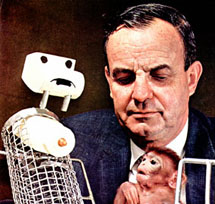 |
| Harry Harlow |
 |
| Love at Good Park, by Deborah Blum |
This past semester I read a very interesting book entitled "Love at Goon Park." It is a biography of Harry Harlow, one of the prominent psychologists in the study of affection and attachment, and probably one of the reasons why your mother held you as a child.
Before Harlow's time, in the first half of the 20th century, the world of science and psychology was charging ahead into misdirected "progress" as it so often does. Psychologists believed that a child's bond with its mother was based only on the mother as a food source, and any emotion were just conditioned responses to external stimuli. Any discussion of love or affection in child rearing was deemed unscientific, or just mushy sentimental fluff.
Some scientists, like Watson with his little Albert experiments, took this thinking too far. In more of a case study than a true experiment Watson took an infant named Albert and conditioned him to fear anything furry or white, like a rabbit. Watching videos of the process scares even me and looks like an old man just terrorizing a helpless child. However, thinkers of the day took this "experiment" to prove how children are just conditioned to do certain things. In fact, Wilson went on to write a best-selling book where he cautioned parents of the damaging consequences of love and affection.
 |
| The "Baby Tender" created by Skinner |
Forgive me for saying this, especially since I have the benefit of 20/20 hindsight vision, but these ideas were dumb. Especially given the evidence against it. The isolation that so many scientists were calling for was in fact damaging the children. In orphanages where children lacked the love and affection mortality rates were astronomical. Children would literally turn their faces to the wall and die from lack of will to live, which resulted from a lack of love. The children were living in deplorable circumstances.
One anecdote tells of an orphanage where mortality rates were high in all sections of the hospital...except for one. All the researchers strove to find out the difference. Diet? Peers? What was it? The answer was that when the cleaning lady in charge of that section of the hospital came in at night, she would pick up the babies and hold them while she worked.
 Harry Harlow enters the picture with his monkey studies. A famous experiment of his, which is featured on the cover of the book above, is where he took infant monkeys and gave them surrogate mothers. The surrogates were made of wire and wood. Two of these surrogates were placed side by side. One had a milk bottle, and the other was wrapped in a terry cloth to make it warm and soft. Monkeys spend a vast majority of their time with the softer mother and only went to the wire mother when they needed food. This debunked the thinking that we form our relationship based on food alone, and showed instead that we need love, we need affection, that is what matters most to us.
Harry Harlow enters the picture with his monkey studies. A famous experiment of his, which is featured on the cover of the book above, is where he took infant monkeys and gave them surrogate mothers. The surrogates were made of wire and wood. Two of these surrogates were placed side by side. One had a milk bottle, and the other was wrapped in a terry cloth to make it warm and soft. Monkeys spend a vast majority of their time with the softer mother and only went to the wire mother when they needed food. This debunked the thinking that we form our relationship based on food alone, and showed instead that we need love, we need affection, that is what matters most to us. |
| In a Romanian Orphanage |
After battling the zeitgeist of his day Harlow, and others, were able to show us just how much we need love. This was able to prevent situations seen in the hospitals and mortality rates dropped significantly. It now became a thing of the past. At least...it should have. However, orphanage situations in Romania mirror quite close to the way things were run in the early 1900's. Bridge of Love describes the situation as follows, "Babies and toddlers stayed in their cribs nearly all day, starved for love and attention. The bedroom walls were bare, and a cold breeze seeped through the windows of the poorly heated orphanage/hospital.
There were no blankets or toys in the room, and the workers changed the babies’ diapers in silence. The toddlers rocked their little bodies back and forth for hours, the only stimulation they could create. The older toddlers banged their heads on the side of the crib—over and over—creating a new noise and huge lumps on their heads.
Laurie described the situation as “children living in a zoo.” They each had their own cage from which they couldn't escape. Most of the children had been abandoned at birth, with little or no information about them left behind. There were no plans for these children—they just existed."
It makes me sad when I'm reading a journal article on an attachment or rearing study and instead of some monkey experiment, the researchers were just able to go to Romania and observe the effects there. This is why I feel strongly about what I'm doing, and I'll explain further in later posts. These children need help, and we are in a position to offer it.
No comments:
Post a Comment